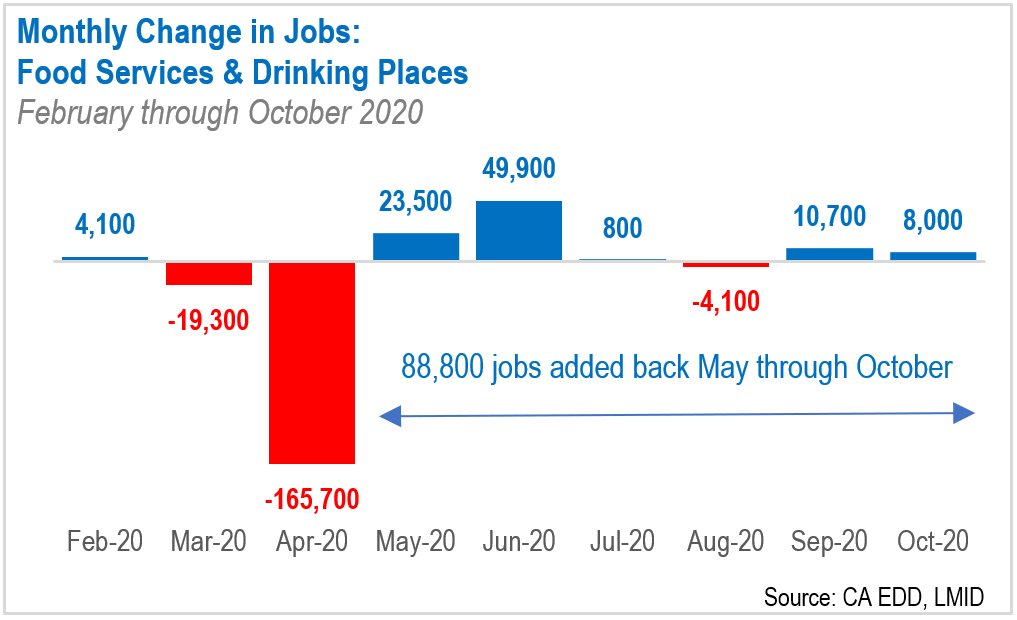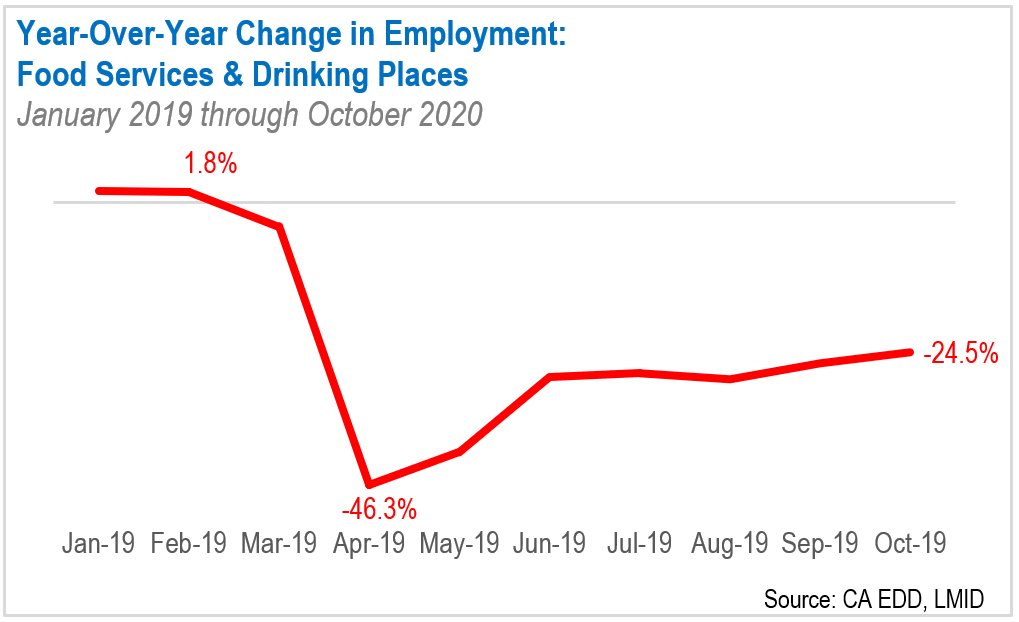December 7, 2020
Restrictions on Outdoor Dining in Los Angeles County: How Many Jobs in Restaurants and Drinking Places Could Be at Risk?
Clearing up a misquote of LAEDC statistics
Dear members, partners and friends:
When the Safer-At-Home order was issued on March 19th in Los Angeles County, building upon the statewide Stay-At-Home order issued by Governor Gavin Newsom, The Los Angeles County economy experienced an unprecedented shutdown as all nonessential activities were mandated to close in order to mitigate the spread of COVID-19. We found ourselves in an instant recession, stemming from both the supply-side and demand-side shocks related to this exogenous event, the global pandemic.
On April 21, 2020, just one month into the Safer-At-Home Order, the LAEDC Institute for Applied Economics published Employment Impact of COVID-19: Southern California containing preliminary estimates of what the potential job loss[1] related to COVID-19 could look like, in the larger 10-county Southern California region[2], in May 2020 under then current conditions, without any kind of government intervention. This region accounted for 10.3 million jobs in 2019, and it includes the important hub of Los Angeles MSA (comprised of Los Angeles and Orange counties), which itself contributed 6.5 million jobs to the economy in 2019. In the report, we identified that Food Preparation and Serving Related Occupations [3](SOC 35-0000) were poised to experience the most job losses of any major occupational group; employment in May 2020 could have declined by up to 68.8 percent (from the 1.0 million jobs in May 2019), year-over-year, in this major occupation group without government intervention, potentially affecting over 694,000 workers across all of Southern California.
At the beginning of the pandemic there were so many unknowns, and concerns about proper social distancing and possible transmission of the virus in restaurants and drinking establishments led to the shutdown of bars, breweries and tasting rooms and the suspension of on-site dining options at restaurants, restricting them to provide food and beverage services only via drive-through or other pick-up and delivery options.
Pre-pandemic, Los Angeles County had 398,500 jobs in the food services and drinking places industry in February 2020, accounting for 8.6 percent of the 4.6 million total nonfarm jobs across the County. Restaurants and drinking establishments have been among the hardest hit by the efforts taken to mitigate the spread of COVID-19, the industry experienced the most job losses in March and April, when the initial Safer-At-Home Order was the most severe, shedding 185,000 jobs from its payrolls in just two months which was the 46.4 percent of total jobs in the industry in February.
As the number of cases in the County began to plateau, restaurants were able to reopen the last week of May as long as protocols were adhered to. However, the subsequent spike in the number of new cases in Los Angeles County over the summer, which peaked in July, led to changes in the order that once again suspended dine-in services, but allowed on-site outdoor dining options for their customers to continue. With on-site dining options allowed, in LA County from May through October (the most recent data available), 88,800 jobs have been added back to payrolls in the restaurant and drinking places industry; 48 percent of the 185,000 jobs lost between March and April have been recovered.
The onset of the cold and flu season brought with it a third spike in the number of new cases of COVID-19. A newly revised health order released by the County of Los Angeles Department of Public Health on November 25, 2020 states that restaurants, breweries and wineries may once again only offer food and beverage via take-out, drive thru or delivery effective November 25 – December 17, 2020. If we look at the number of jobs added between May and October of this year, when outdoor dining options were allowed, it can give us a general idea of layoffs with the loss of outdoor dining; the 88,800 jobs recovered from May through October are those that stand to be the most vulnerable with the suspension of on-site outdoor dining options in Los Angeles County over the holidays.
LAEDC also notes that the industry tends to employ a higher percentage of people of color, younger workers, and women, compared to all-industries in LA County. Therefore, in LA County, people working in food services and drinking places and their families may lose a source of income heading into the holidays, which would be a burden on those communities which have already suffered disproportionately under COVID-19.
The pandemic has caused record breaking unemployment and business closures across Los Angeles County with food services and drinking places being among the hardest hit due to mandated closures, restrictions for business operations and changes in consumer behavior. Across the nation, the National Restaurant Association reported more than $120 billion of lost revenue in the restaurant industry during the first three months of COVID-19. Businesses in the industry have had to make difficult decisions to lay off or furlough their employees in an attempt to keep their doors open, but many have been forced to close permanently. Now more than ever, public officials are engaged in a balancing act between what’s best for businesses, jobs, and the local economy and what’s best for public health. The LAEDC Institute for Applied Economics will continue to offer updated data and insights on the economic implications of the pandemic as it continues to unfold.
About Los Angeles County Economic Development Corporation (LAEDC) www.laedc.org
LAEDC drives action in support of a reimagined Los Angeles regional economy that is growing, equitable, sustainable and resilient, and provides a healthy and high standard of living for all. A public-benefit nonprofit celebrating its 40th year of working collaboratively to improve the lives of people through economic inclusion, LAEDC is a trusted leader working on behalf of the Los Angeles County region.
LAEDC also believes that being Safer at Work is essential to reduce transmission. Business owners, staff and patrons all have a role to play adhering to safety guidelines, which will benefit the health of all in the community and allow both health and economic conditions to improve.
Support and resources for struggling businesses can be found at LAEDC.org, including LAEDC’s business assistance team which has increased its capacity to provide no-cost, confidential consulting for small businesses and nonprofits facing challenges.
[1] Estimates were based on proximity of work required for occupations in combination with the identification of “high risk” industries, like food services and drinking places, to create probabilities that were then applied to occupational data to create these figures.
[2] We focused on quantifying the potential employment impacts for the larger Southern California region which included eight Metropolitan Statistical Ares (MSAs) that span across ten counties that extend from San Luis Obispo to San Diego, and out to Nevada and Arizona at its farthest East.
[3] Workplaces (establishments) are classified into industries based on their principal product or activity, as determined from information on annual sales volume. Occupations with similar job duties, and in some cases skills, education, and/or training, are grouped together regardless of the industry.




